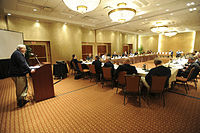
Photo from wikipedia
Abstract We offer a conceptual framework where management couples natural and human systems backed by a representative synthesis of the literature studying US family forest owners. Within a socio-ecological forest… Click to show full abstract
Abstract We offer a conceptual framework where management couples natural and human systems backed by a representative synthesis of the literature studying US family forest owners. Within a socio-ecological forest system, management occurs at the intersection of resources and conditions intrinsic to owners and land with interactions influenced by extrinsic social and natural factors. Among extrinsic factors, public policy stands out as a major instrument society uses to influence how family forest owners manage their parcels. We discuss how public policy tools influence individual management preferences occurring within a system of forest owners. In the US, forestry extension programs are a major conduit for achieving public policy objectives by increasing family forest owners’ knowledge and reducing barriers to purposeful management, among other services. We conclude with insights into documented relationships linking family forestlands and owners to larger natural and human systems and identify areas where more research is warranted.
Journal Title: Landscape and Urban Planning
Year Published: 2019
Link to full text (if available)
Share on Social Media: Sign Up to like & get
recommendations!